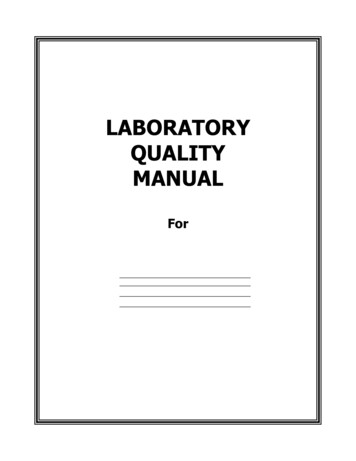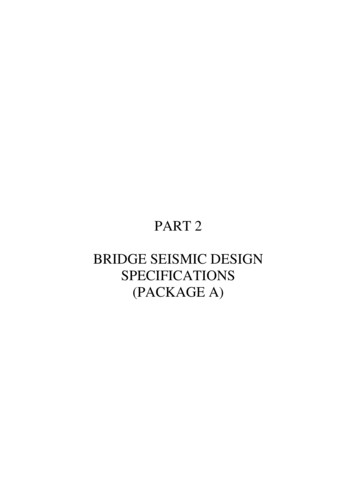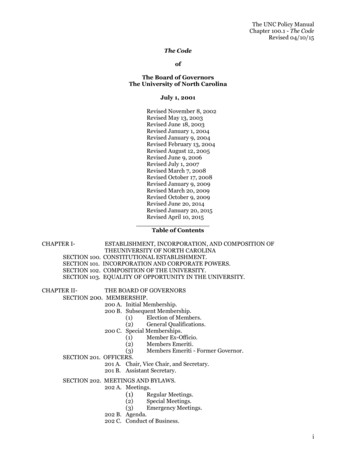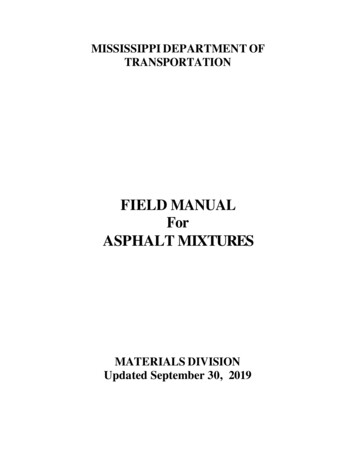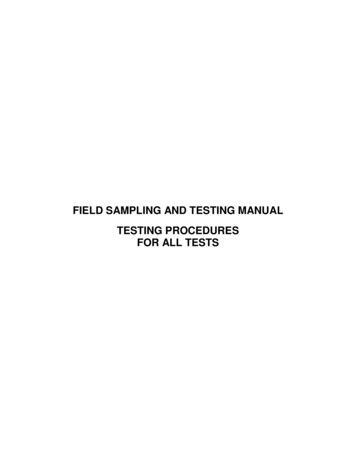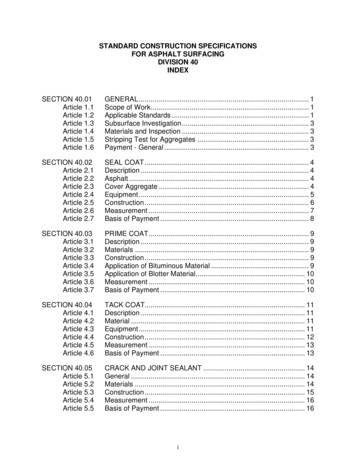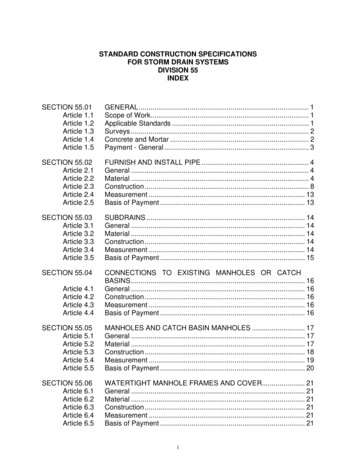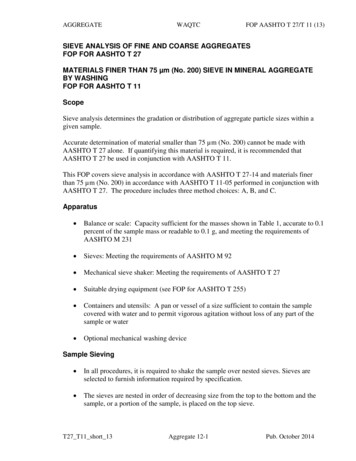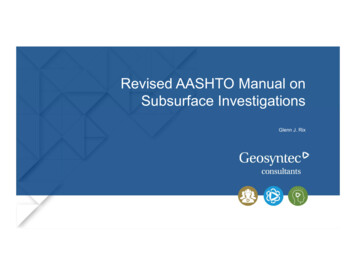
Transcription
Revised AASHTO Manual onSubsurface InvestigationsGlenn J. Rix
Previous Edition
Evolutionary Change in the Past 30 Years Geotechnical uncertainty and riskDevelopments in in-situ testmethods and their interpretation toestimate soil and rock propertiesRock mass characterizationGeotechnical reports foralternative project deliverymethodsGeotechnical instrumentationGeotechnical data management
Geotechnical Uncertainty and Risk Technical risks– Inability to satisfy desiredperformance requirements forone or more limit states Financial risks– Claims, change orders, cost andschedule overruns attributed todiffering subsurface conditions Load and resistance factordesign
Geophysical Methods New methods– Surface wave methods– Electrical resistivity imaging– Ground penetrating radar New applications– Seismic site classification viaVs,30
In Situ Testing Increased standardizationof the SPTWidespread use of CPTDevelopment of methods toestimate engineeringcharacteristics andproperties of soils directlyfrom in situ tests
Drilling and Sampling of Soil and Rock Direct-push sampling techniques– Continuous hydraulic systems– Continuous sonic drilling– Vibracore Measurement while drilling (MWD)
Laboratory Testing of Soil and Rock Quantitative assessment of sample disturbance– X‐ray radiography– Observed changes in vertical strain and void ratio duringreconsolidation
Interpretation of Soil and Rock Properties Soil properties– Soil type– Unit weight– Preconsolidation or yieldstress– Drained and undrainedstrength properties– Lateral stress state– Modulus– Coefficient of consolidation– Hydraulic conducivity Rock mass properties– Rock Mass Rating– Geological Strength Index– Strength estimates Hoek et al. (2002) Barton (2002)
Reporting Geotechnical Information Alternative projectdelivery methods– Construction manager atrisk– Design‐build– Negotiated generalcontractor
Geotechnical Instrumentation Sensor technologiesCommunicationtechnologiesAutomated datacollectionData storage andinformation managementField installationmethodsDunnicliff (1982)
Management of Geotechnical Data Unprecedented amountof data is available, butis usually not readilyaccessibleTools such as DIGGSoffer a standardized datatransfer protocol to helpmanage large amountsof data
Other New Developments Increased emphasis onquality assurance/qualitycontrolIncreased emphasis onhealth and safetyIncreased use ofoutsourcing forsubsurface investigationsTechnology transferstrategies
Objectives of the Revised Manual Develop a concise*, comprehensive document that willbe invaluable for planning, executing, and usingsubsurface investigations for transportation projectsDefine a reasonable minimum standard of practice for amodern geotechnical site investigationEnable geoprofessionals to develop cost-effectivedesign solutions while optimizing life-cycle costs,ensuring public safety and environmental sustainability,minimizing contract disputes and cost overruns, andaccelerating construction* The 1988 edition of the manual is 391 pages vs. 373 pages for the revised version
Intended Users State transportation agencies who are responsible for:– developing the scope of subsurface investigations,– selecting and managing qualified consultants and contractors to performthe investigation, and– understanding the results of the investigation Consultants and contractors who are responsible for:– executing a sound site investigation program– using the results to develop a ground model for the project– reporting the results in a manner that facilitates peer review,communication with stakeholders, and potential future uses of theinformation
Project Team Geosyntec Consultants––––––––Glenn RixNjoroge WainainaBob BachusAli EbrahimiRodolfo SancioBrooke FaiteMaria Limas‐SuarezLaura Leighton (TechnicalEditor) Georgia Institute ofTechnology– Paul Mayne
Organization of the ManualTopicPlanning the InvestigationUpdated Manual1988 ManualChapter 1 - IntroductionChapter 1 - IntroductionChapter 2 – GeotechnicalUncertainty and RiskChapter 2 – Subsurface DataRequirementsChapter 5 – Geologic ConstraintsChapter 2 – Subsurface DataRequirementsChapter 3 – Conduct ofInvestigationsChapter 4 – Field MappingChapter 3 – SubsurfaceInvestigation Processes
Organization of the ManualTopicUpdated ManualChapter 4 – GeophysicalInvestigationsChapter 5 – In Situ Testing ofSoil and RockChapter 6 – Drilling andSampling of Soil and RockExecuting the InvestigationChapter 7 – HydrogeologicCharacterizationChapter 8 – Laboratory Testingof Soil and Rock1988 ManualChapter 6 – EngineeringGeophysicsAppendix B – In Situ BoreholeTestingAppendix C – In Situ TestingProceduresChapter 7 – SubsurfaceExplorationAppendix A – Drilling, Sampling,and Installation ProceduresChapter 8 – HydrogeologyAppendix B - In Situ BoreholeTestingChapter 9 – Laboratory Testing ofSoil and RockAppendix D – Laboratory TestingProcedures – Soils and Rock
Organization of the ManualTopicInterpreting the Results ofthe InvestigationReporting and Presentingthe Results of theInvestigationUpdated Manual1988 ManualChapter 9 – Interpretation of SoilPropertiesChapter 10 – Interpretation ofRock Mass PropertiesAppendix E – MaterialsClassificationAppendix E.6 – Classification ofRockChapter 11 – Compiling,Reporting, and PresentingGeotechnical InformationChapter 10 – Compilation andPresentation of GeotechnicalInformation
Organization of the ManualTopicSupplemental InvestigativeInformationSupplementalAdministrative InformationUpdated Manual1988 ManualAppendix A – GeotechnicalInstrumentationAppendix B – Applications ofGeotechnical InstrumentationAppendix C – Evaluation ofExisting Bridge Foundations forReuseAppendix G - InstrumentationAppendix D – Management ofGeotechnical DataAppendix E – Quality AssuranceSystemsAppendix F – Health and SafetyAppendix G – ContractingSubsurface InvestigationsAppendix H – TechnologyTransfer StrategiesNot includedNot includedNot includedNot includedNot includedChapter 7.3 – Contracts andSpecificationsNot included
Chapter 2: Geotechnical Uncertainty and Risk Uncertainties regarding subsurface soil and rockconditions are a significant contributor to technicaland financial risks.Broadly, the purpose of a subsurface investigationis to gather sufficient information about soil androck conditions to aid in identifying geotechnicalrelated risks and reducing them to tolerable levels.Subsurface investigation strategies for reducinggeotechnical risks are presented.
Chapter 3: Subsurface Investigation Processes Identifying the types of data required to address the anticipatedgeotechnical risks and performance issuesSelecting the most appropriate investigation equipment for theanticipated site conditionsSelecting the appropriate scope and methods for:–––––geophysical testingin situ testingdrilling and samplingevaluating groundwater conditionslaboratory testing
Chapter 4: Geophysical Methods Surface geophysical methods– Seismic Refraction Reflection Surface wave– Electrical and electromagnetic Resistivity Time‐domain and frequency‐domain electromagnetic Ground penetrating radar– Potential field Microgravity Magnetometry Self‐potential
Chapter 4: Geophysical Methods Borehole geophysical methods– Seismic Crosshole Downhole (e.g., seismic CPT)– In‐hole logging MechanicalElectrical and electromagneticNuclearOptical and acoustic televiewerSeismic logging (e.g., P‐S suspension logging)
Chapter 5: In Situ Testing of Soil and Rock
Chapter 5: In Situ Testing of Soil and Rock Borehole test methods– Standard penetration test– Vane shear test– Pressuremeter test Direct-push test methods– Cone penetration test– Flat plate dilatometer test In situ test methods for rock– Plate load test– Flat jack test
Chapter 6: Drilling and Sampling of Soil and Rock Field equipmentMethods for advancing boreholes– Measuring (or monitoring) while drilling Soil samplingRock coring methodsLogging boringsBoring closure
Chapter 7: Hydrogeologic Characterization Groundwater levels and pressures––––– Existing information sourcesGeotechnical boringsMonitoring wellsPiezometersGeophysical testingAquifer characteristics–––––Hydraulic age coefficient (confined aquifers) or specific yield (unconfined aquifers)
Chapter 8: Laboratory Testing of Soil and Rock Quality assurance– Sample tracking, transportation, storage and handling– Quantitative assessment of sample disturbanceIndex propertiesSoil classificationCompactionHydraulic conductivityConsolidationShear strengthDynamic propertiesTests for subgrade soils and unbound basesLaboratory tests for rock
Chapter 9: Evaluation of Soil Properties Subsurface stratigraphySoil classificationUnit weight ()Preconsolidation stress oreffective yield stress)( OCR Shear strength ( , , )Lateral stress state ( )Modulus ( , )Coefficient of consolidation ( )
VERY POOR Slickensided with softclay coatingPOOR - Slickensided,highly weathered withfillingFAIR - Smooth,moderately weathered andalteredGOOD - Rough, slightlyweathered, iron-stainedVERY GOOD - Very Rough- fresh unweatheredGeological StrengthIndex (GSI)SURFACE CONDITIONSChapter 10: Evaluation of Rock Mass PropertiesRock Mass Strength ‐ Hoek ‐ Brown Model (Hoek 2007) ‐ Example Calculation for MarblePROBLEM DATAGSI qu (MPa) mi GWT depth(m) ROCK STRUCTUREBLOCKY - well interlockedundisturbed rock masscomposed of cubicalblocks with 3 sets ofintersecting discontinuitiesVERY BLOCKY - interlockedpartially-disturbed rockmass with multi-facetedblocks having 4 joint setsDISTURBED-BLOCKYSEAMY: folded withangular blocks formed bymany intersecting jointsets with bedding planesor schistocity90Not applicable7060504030DISINTEGRATED ROCK:Poorly interlocked andheavily broken with mix ofangular & rounded piecesLAMINATED-SHEARED:lack of blockiness due toclose spacing of weakschistocity or shear planes3 (kN/m ) Depth (m) 80Decreasing Interlocking of Rock PiecesINTACT or MASSIVErock with few widelyspaced discontinuities20Not applicable10Decreasing Surface Quality of DiscontinuitiesCalculated GSI ParametersEquivalent RMR 50mb/mi Reduction 0.140s (Rock Mass) 0.002221.262mb (Rock Mass) 45379225a (exponent) 0.5085D (disturbance) 0MIT Stress SpaceEffective Principal StressesDepth 3 v 1'uo 3' 1'z (m)(kPa)(kPa)(kPa)(kPa)(kPa)qp'(kPa) (kPa)MOHR-COULOMB CRITERIONRatioSecantq/p' 'Incremental Parametersc', kPa 71.570.425327629530932361.259.358.157.356.6MIT Parameters:q ( 1'- 3 ')/2Mean 29158.5p' ( 1 ' 3 ')/2Values(kPa)(deg)ABCDE
Chapter 11: Compiling and Reporting GeotechnicalInformation Factual information–––––––Preexisting data resourcesRemote sensingGeophysical informationIn situ testingHydrogeologic informationLaboratory testingInstrumentation Interpretive information–––––Performance criteriaGround modelDesign recommendationsConstruction considerationsRecommendations forgeotechnical instrumentationand monitoring– Information for LRFD
Chapter 11: Compiling and Reporting GeotechnicalInformation Geotechnical data reportsGeotechnical baseline reportsGeotechnical design memoranda
Complementary Resources AASHTO Load and Resistance Factor Design BridgeDesign Specifications (AASHTO, 2017)FHWA Geotechnical Engineering Circular No. 5 (FHWA,2017)NHI Courses on Soils and Foundations (FHWA, 2006)U.S. Army Corps of Engineers Engineer Manual 1110-11804 on Geotechnical Investigations (USACE, 2001)ASTM guides and standards
Availability National AcademiesPress– bsurface‐investigations Currently under reviewby AASHTO
Acknowledgements American Association of State Highway andTransportation OfficialsNational Cooperative Highway Research ProgramNCHRP Project Managers– Mr. David Reynaud– Dr. Waseem Dekelbab NCHRP Project Panel
Define a reasonable minimum standard of practice for a modern geotechnical site investigation . - Standard penetration test - Vane shear test - Pressuremeter test Direct-push test methods - Cone penetration test - Flat plate dilatometer test In situ test methods for rock - Plate load test - Flat jack test.
